Iconography of the image of the Blessed Virgin Mary
Consultant of the parish counseling service Raisa Konstantinovna Egorova prepared and gave a lecture on the iconography of the image of the Blessed Virgin Mary.
Her lecture was informative. But the main thing in it was not the abundance of information, but the content filled with theological meaning. Numerous information on the iconography of the image of the Blessed Virgin Mary, available in various sources, was not just conscientiously retold, but creatively comprehended. Thus, when listing the types of images of the Most Holy Theotokos, she each time turned to the icons of the Mother of God located in all three aisles of our Assumption Church. And when examining specific icons, Raisa Konstantinovna paid attention not only to the attributes of the clothing of the Most Holy Theotokos and Her Divine Son, but also revealed the meaning of the icon from a dogmatic point of view.
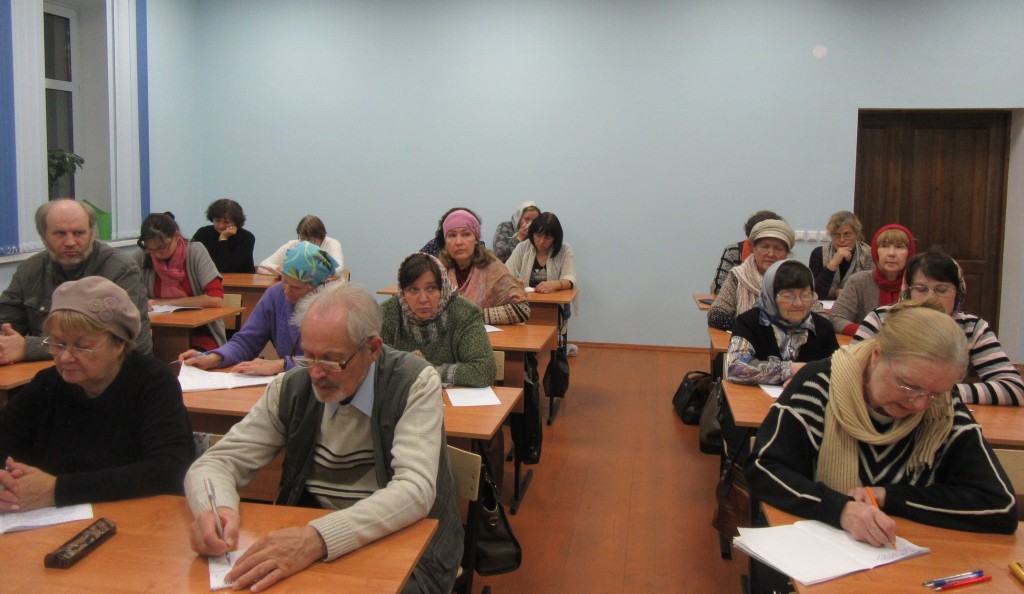
The first Christians who believed in Christ and accepted His teachings, at the same time learned to love and honor His Most Pure Mother, whom He Himself pointed to as the Intercessor and Patroness when, while on the cross, He gave Her the entire Christian race as an inheritance in the person of John the Theologian .
Images of the Mother of God occupy an exceptional place in Christian iconography, testifying to Her significance in the life of the Church. The veneration of the Mother of God is based on the dogma of the Incarnation: “The indescribable word of the Father, from you the Mother of God is described incarnate...” (kontakion of the first week of Great Lent). The first Christians did not know icons in our understanding of the word.
The oldest image that has survived to our time is the catacomb paintings. The catacombs are burial caves in Rome where early Christians held worship and images from early Christian times are preserved on the walls and stones. These images contain scenes of the Annunciation and scenes of the Nativity of Christ. The scene of the worship of the Magi is often encountered.
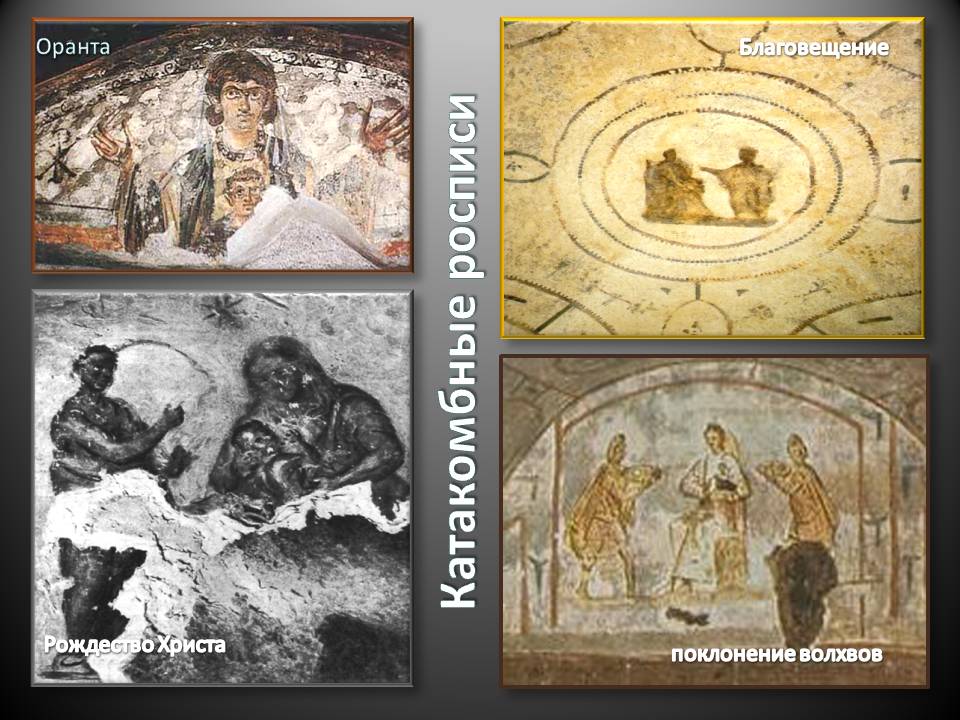
In the 3rd century, relief images of Gospel stories, parables, allegories, etc. became widespread, but the icon was still far away. The first scenes depicting the Mother of God were of a historical nature; they illustrated the events of sacred history, but in essence they were not yet the shrines in front of which Christian prayers were offered to the Most Pure Virgin.

The Council of Ephesus in 431 condemned the heresy of Nestorius, who did not fully recognize the union of two natures in the person of Christ - Divine and human, and therefore denied the Motherhood of the Virgin Mary, calling Her “Christ Mother”, and not “Theotokos”. The Council dogmatically approved the right of the Virgin Mary to be named. Mother of God, because Through the birth of Jesus from the Holy Spirit, Mary participates in the Mystery of the Incarnation. Christian culture has been searching for several centuries for an adequate way to express the Christian revelation.
Even in the days of the earthly life of the Mother of God, both near and far hurried to her to see and hear Her, to receive blessing and instruction from Her; those who did not have the opportunity to appear before the Mother of their Lord grieved, expressing an ardent desire to see at least an image of the face of the Mother of God. The Apostle Luke heard this pious desire many times and from many Christians, and in order to satisfy them, he depicted on the board the face of the Mother of God with the Eternal Child in her arms; then he painted two more icons and brought all three to the Mother of God. Seeing Her image on the icons, She repeated Her prophetic word: “From now on, all generations will bless Me.” And she added: “May the grace of the One born from Me and Mine be with these icons.”

There is another legend about the prototype - this is a miraculous image of the Mother of God, which arose during Her lifetime, on the pillar of a temple built in the city of Lydda (not far from Jerusalem). The holy apostles Peter and John the Theologian prayed to the Mother of God to visit and with her presence illuminate and bless the built temple.
The Most Pure Virgin said: “Go in peace, there I will be with you.” Arriving at the temple, they saw on one of the supporting pillars ( Column) marvelous beauty, miraculous image of the Blessed Virgin Mary. Then the Mother of God herself visited the Lydda temple. Miracles began to occur from this image. Since then, having learned about the miraculous phenomenon, crowds of pilgrims from all over the world flocked to the temple.

In the 4th century, Emperor Julian the Apostate came to power. Stonemasons were sent to the temple to destroy the miraculous image. However, no matter how hard they tried to chip away at the sacred image, it did not disappear, but only went deeper inside the pillar, and remained just as bright and beautiful. Realizing the futility of their efforts, they left. The fear of the power of the Mother of God turned out to be stronger than the fear of the emperor.
In the 8th century, the atrocities of the iconoclasts were added to the persecution of Christians in the Roman Empire. Patriarch Herman of Constantinople, having visited Jerusalem and Lydda, was not afraid and ordered to write a copy of the miraculous, miraculous icon of the Mother of God. He took it with him to Constantinople and prayed before it every day. But for his zealous veneration of icons he was deposed and expelled. Anticipating his death, he decided to save the icon. Having written a letter to Pope Gregory explaining the situation, he hid it in the icon, went with it to the seashore and released the shrine to the will of God. The next day, the icon miraculously reached Rome and remained in the altar of the Church of St. Apostle Peter. More than a hundred years later, when the veneration of icons was restored in the East, during a service, in front of all those praying in the church, the icon was removed from its place and over the heads of the believers, it came out of the church through the air. Soon the icon sailed to Constantinople and was brought to Emperor Michael and his mother, Queen Theodora, who restored icon veneration. From that time on, the icon received another name: Roman (Lydda).
After the Council of Effes, the first icons of the Mother of God, in the proper sense of the word, appear. That is, icon painting emerges as a tradition.
Through the image of the Mother of God the depth of the Theanthropic relationship is revealed to us. The Virgin Mary, who gave life to God in His human nature, becomes the mother of God (Theotokos). And since this motherhood is supernatural, Her virginity is also mysteriously preserved in it. The secret of the Mother of God lies in the fact that through Virginity and Motherhood She is a new Creation and the veneration of Her is connected precisely with this.
The appearance of the Mother of God, in addition to the most ancient images, is known from descriptions of church historians. According to a legend preserved by the church historian Nicephorus Callistus, who borrowed his description from St. Epiphanius of Cyprus, he writes: “The Mother of God was of average height or, as others say, slightly more than average; golden hair; eyes are fast, with pupils the color of olives; the eyebrows are arched and moderately black, the nose is oblong, the lips are flowering, full of sweet speeches; the face is not round and not sharp, but somewhat oblong; her hands and fingers are long... Regarding the clothes she wore, She was content with their natural color...".

On icons, the Mother of God is traditionally depicted in certain clothes: maforium - outer clothing, wide, round when unfolded. In the middle there is a round slot for the head to pass through; the edges of this slot near the neck are trimmed with a wide or narrow border. Maforius was dressed over a tunic and the length fell slightly below the knees. Tunic is a long undershirt that reaches the floor. Her color on the icons of the Blessed Virgin is set to blue, as a symbol of virgin purity. But it can be different shades of blue, dark blue and dark green. A woman of that time should always cover her head, and on the icons of the Mother of God we always see a light scarf (cap) on Her head, picking up and covering her hair, over which a veil is worn. The coverlet, like the maforium, was round, cut from the front to the center or with a slit for the face. Its length was up to the elbows. In iconography, tone A The Mother of God's dress is dark red - as a reminder of the royal origin of the Most Pure One and the suffering She endured. In addition, red, like the color of blood, testifies that from her, the Pure Virgin, the Son of God borrowed His flesh and blood. The edges of the boards are trimmed with gold border and fringe. The golden border - a sign of the glorification of the Queen of Heaven - symbolizes Her presence in the Divine light and Her participation in the glory of the Lord and the grace of the Holy Spirit, poured out on the Blessed Virgin at the moment of conception. Sometimes the Virgin's clothes are golden, which symbolizes the flow of God's grace, and occasionally we can see the Mother of God dressed in blue maforia. For the icon painter, it is more important to emphasize the Virginity, the purity of the Mother of God. An indispensable part of the Mother of God's head veil are three stars. This is a symbol of Her Ever-Virginity. She is a Virgin before the Nativity of Christ (an asterisk on her right shoulder), a Virgin at the very moment of the incomprehensible birth of the Son of God (an asterisk on her forehead), and remains a Virgin after the birth of Her Divine Son (an asterisk on her left shoulder). At the same time, 3 stars are also a symbol of the Holy Trinity. On some icons the figure of the Divine Child covers one of these stars, A I exchange the incarnation of the Son of God - the Second Hypostasis of the Most Holy Trinity. Another important detail of the Virgin’s attire is the shoulder straps ( oversleeves). Armbands are a detail of the vestments of priests; on icons they are a symbol of the service of the Mother of God (and in Her person - the entire Church) to the Head of the Church, the High Priest Jesus Christ.
Since the 6th century, the inscription on the icon “Mother of God” has been given, according to tradition, in Greek abbreviation.
On the Mother of God icons, the robe of the Divine Infant Christ is almost always golden yellow, in different shades of color e and are decorated with a golden assist ( along the folds of clothing there are strokes of gold or silver leaf) - a sign of Divine Light. By this, the Holy Church distinguishes His infancy from the usual for all people. And it points to His co-eternal Being, co-throne with God the Father.
Orthodox tradition, in exceptional cases, allows the depiction of women with bare heads.
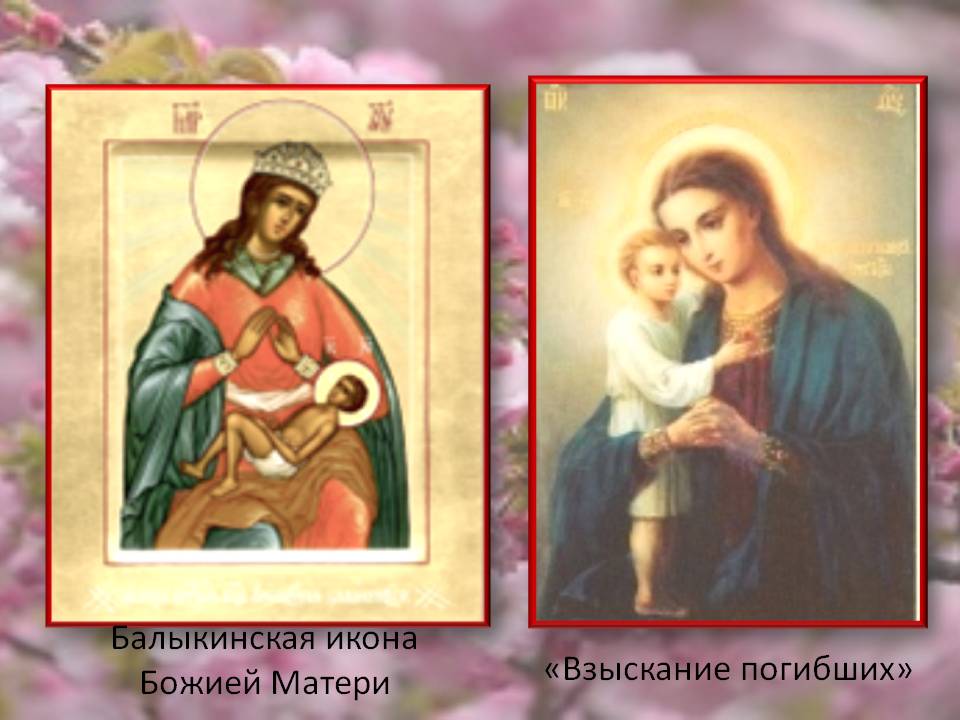
Usually this is how Mary of Egypt is written as a sign of her ascetic - repentant lifestyle, which replaced her previous dissolute lifestyle. In all other cases, the image with the head covered is accepted. But in some iconographic versions we see an image of the Mother of God with her head uncovered, for example: the Moscow image of the Mother of God “Seeking the Lost.” In some cases, the board is replaced with a crown (crown, diadem), for example: Balykino Icon of the Mother of God.
The custom of depicting the Virgin Mary with her head uncovered is of Western origin, as a sign of Her Ever-Virginity. The covered head of the Mother of God is not just a tribute to the Eastern Christian tradition, but a deep symbol - a sign of Her Motherhood and complete belonging to God. Even the crown on Her head cannot replace the covering, for the crown (crown) is a sign of the Kingdom. Indeed, the Mother of God is the Queen of Heaven, but this royal dignity is based solely on Her Motherhood, on the fact that She became the Mother of the Savior and our Lord Jesus Christ. Therefore, it is correct to depict the crown on top of the plate, as we see on the icons of the Mother of God: the Czestochowa Icon, “Mammal”, “Support of Sinners”, “Sovereign”, “Worthy to Eat”, etc.
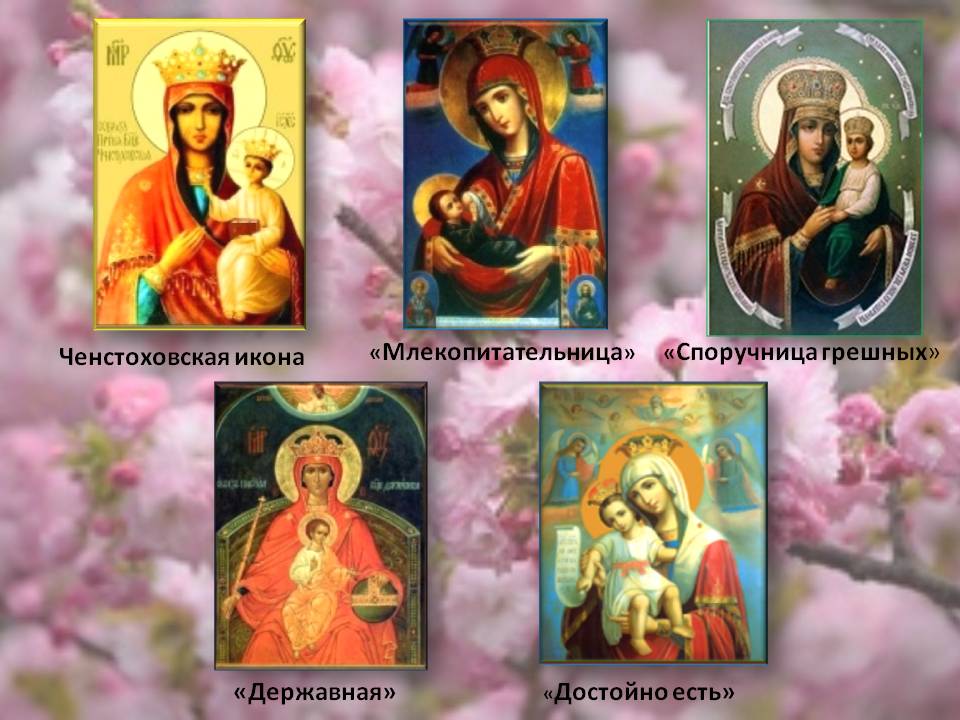
The Mother of God is depicted full-length, sitting, waist-deep, shoulder-deep. In Rus', waist-length icons of the Mother of God became much more widespread, and painting a full-length figure or sitting on a throne was mostly used in monumental compositions - in frescoes and in the iconostasis.

The icon in Rus' was both a prayer image, and a book with the help of which one studied, and a life companion, and a shrine, and the main wealth that was passed on as an inheritance from generation to generation. The icons of the Mother of God were loved all the more because Her image was close to the people’s soul, accessible, the heart was opened to her, maybe even more than to Christ. The popular consciousness was dominated by ideas about God as a Terrible Judge, and the Mother of God as an eternal Intercessor, capable of softening the wrath of God. In the Gospel, Christ performs the first miracle precisely at the request of the Mother, as if yielding to Her in Her intercession for ordinary people. However, in popular imagination, the limits of such intercession could take on disproportionate proportions, distorting the image of Christ. Nevertheless, knowing the love of the people for the Mother of God, Her closeness to the human heart, sometimes naive in its human faith, the Church taught the people of God through the icons of the Mother of God. And with all the accessibility of this image, icons contain the deepest theological meaning.
Conventionally, the entire variety of icons of the Mother of God can be divided into groups, each of which represents the revelation of one of the aspects of Her ministry. The iconographic scheme is an expression of a theological idea. The main, leading icons in the iconography of the Mother of God are three types of icons: “Oranta”, “Hodegetria”, “Tenderness”. According to legend, three icons of the Apostle Luke, presented to the Mother of God, founded these types of icons.
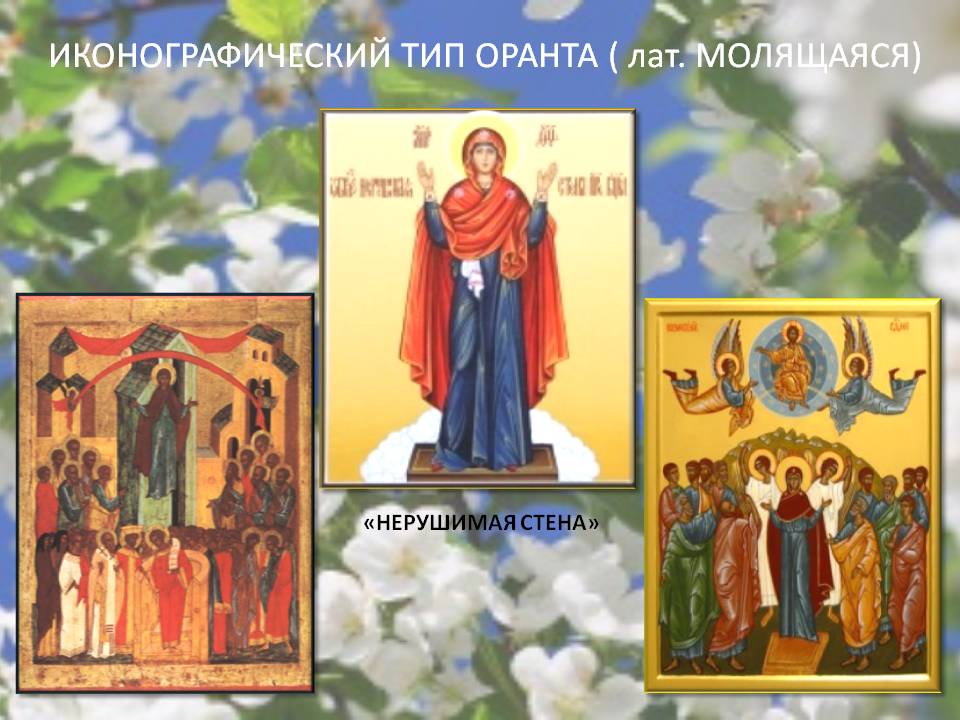
1 type – “Oranta” lat. Praying. The Mother of God is represented with her arms raised and outstretched to the sides, palms outward, i.e. in the traditional gesture of intercessory prayer. This prayer position has been known since Old Testament times. The first images of the Virgin Mary “Oranta” are found already in the Roman catacombs. Her pose is extremely static, majestic and monumental. The Mother of God is of interest in itself, not only as having given birth to Christ, but also as praying for the Christian race. The Mother of God, as it were, opens up to meet Christ, who descends through Her to earth, incarnates in human form and illuminates human flesh with His Divine presence, turning it into a temple - hence the Mother of God “Oranta” is interpreted as the personification of the Christian temple, as well as the entire New Testament Church. An example would be the icon of the Mother of God “The Unbreakable Wall”. The epithet “Unbreakable Wall” is borrowed from the akathist to the Mother of God: “Rejoice, Unbreakable Wall of the Kingdom” (ikos 12). On her belt hangs a lention (towel), with which She wipes away so many tears of the mourners. This image is part of the complex compositions of the holidays of the Ascension, Intercession...

The figure of the Virgin Mary, depicted in full growth with the Infant God in a round medallion at chest level, is called "Great Panagia" , what does it mean "All Holy" . This is the most theologically rich iconographic type and is associated with the theme of the Incarnation. The iconography is based on texts from the Old Testament - the prophecy of Isaiah: “So the Lord himself gives you a sign: behold, a virgin will be with child and give birth to a Son, and they will call His name Emmanuel” (Is. 7:14), and from the New Testament - the words of the Angel in the Annunciation: “The Holy Spirit will come upon You and the power of the Highest will overshadow You, therefore the Holy One who is to be born will be called the Son of God” (Luke 1:35). These words reveal to us the mystery of the Incarnation, the birth of the Savior from the Virgin, the birth of the Son of God from an earthly woman. The medallion symbolizes both heaven, as the abode of God and the womb of the Mother of God, in which the Savior is embodied. An example would be the Mirozh Icon of the Mother of God, etc.
In the 11th-12th centuries, half-length images of icons of the “Great Panagia” type appeared, which became widespread in ancient Russian icon painting and became known as icons. "The Omen" . One of the meanings of the Slavic word zn A Menya is a miracle. And indeed, the image of the Infant Christ in the bosom of the Mother of God is a symbol of the greatest miracle, the miracle of the Incarnation, when the Beginningless and Incontainable God fit into the human body. At the moment of contemplating the icon, the Holy of Holies, the inner Mary, is revealed to the prayer, in the depths of which the God-man is conceived by the Holy Spirit. “Your womb is more spacious” - this is how the Mother of God is called in the akathist. We see Her at the moment of standing before God: “Behold the handmaid of the Lord, let it be done to Me according to Your word” (Luke 1:38). The iconographic type “Sign” is sometimes called "Embodiment".
The word zn A menie is related to the Slavic verb zn A I change - I convene, I call for worship. This reveals the second deep meaning of this iconography: the raised hands of the Mother of God, as a symbol of prayer; Child Christ in a circle as a symbol of the Eucharist; eagle - a rug under the feet is used in the bishop's service, which speaks of standing before God for the entire human race, entrusted in the hands of the Mother of God - a symbol of the concelebration of the entire Church with its Heavenly Primate.
This type includes the “Sign” icon of the Mother of God and the “Inexhaustible Chalice” icon of the Mother of God.

The Icon of the Mother of God “The Inexhaustible Chalice” appeared to the world as an inexhaustible source of help for those who are irresistibly attracted by the destructive passion of wine drinking. The blessing of the Divine Infant is written standing in a cup - the cup of Communion. This thicket is truly inexhaustible, or inexhaustible, because her Lamb is “always eaten and never spent.” And the Mother of God, with her most pure hands raised upward, like a mighty high priest, intercessively offers God this sacrifice - Her slain Son, who has borrowed flesh and blood from Her most pure blood, to the heavenly altar for the salvation of the whole world, and offers it as food to the faithful. She prays for all sinners, wants salvation for everyone, and instead of low, destructive addictions, she calls for an inexhaustible source of spiritual joy and consolation. She proclaims that an inexhaustible cup of heavenly help and mercy is prepared for everyone in need.
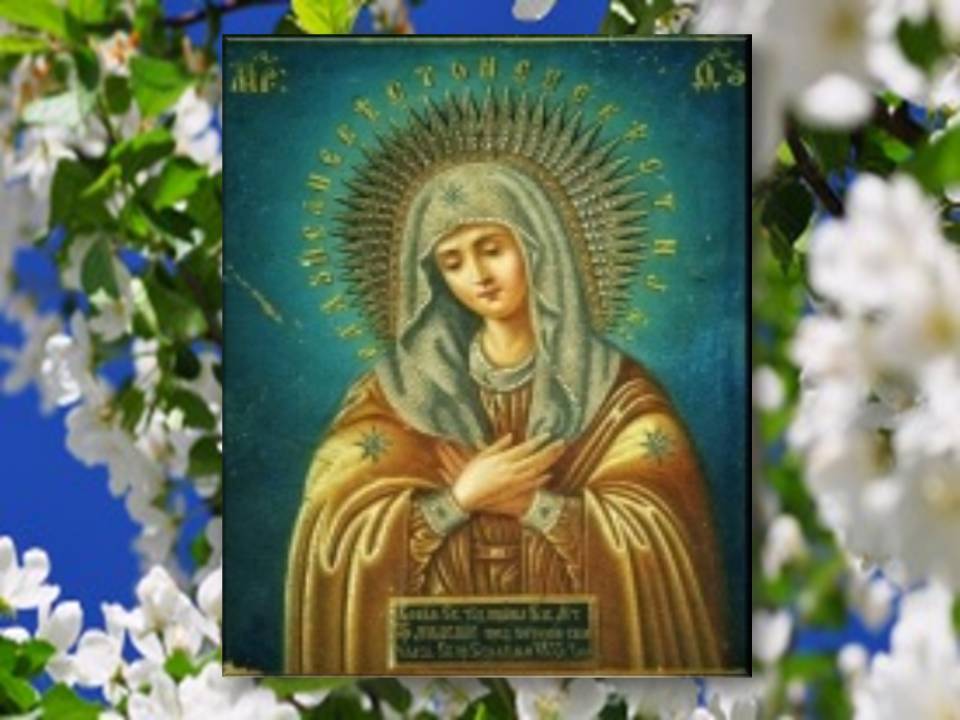
The “Unbrided Bride” icon belongs to the Oranta type; it was the cell icon of St. Seraphim of Sarov. The saint himself called it “The Joy of All Joys.” Before her, kneeling in prayer, he died. The position of the hands crossed on the chest (a gesture of humble prayerful worship) is close in meaning to the Oranta gesture. The image of the Mother of God is revealed here at the moment of Her acceptance of the Good News: “Behold the handmaid of the Lord, let it be done to me according to your word” (Luke 1:38).\

Image type close to the Oranta type Kyriotissa - Greek Mistress, the Virgin Mary is depicted standing full-length, supporting the Baby in the center of her chest with her hand, but She does not pray with her arms outstretched, but holds the Baby. This type of image is sometimes called Nikopea Kyriotissa - Greek Lady Victorious . This image goes back to one of the original Mother of God images, the Sign. The creation of the prototype of Kyriotissa, according to legend, is attributed to the Apostle Luke. Nikopeia Kyriotissa received its name from the fact that in Byzantium the imperial troops asked this image for intercession before battles. The icon was also considered the guardian of the imperial house. The image of the Mother of God “Life-Giving Spring”, which received great veneration, goes back to the prototype of Nikopeia Kyriotissa. In the Orthodox tradition, the Mother of God is called the Life-Giving Source. They glorify Her as the Source of life, for from her will be born Christ - the Way, the Truth, and the Life.
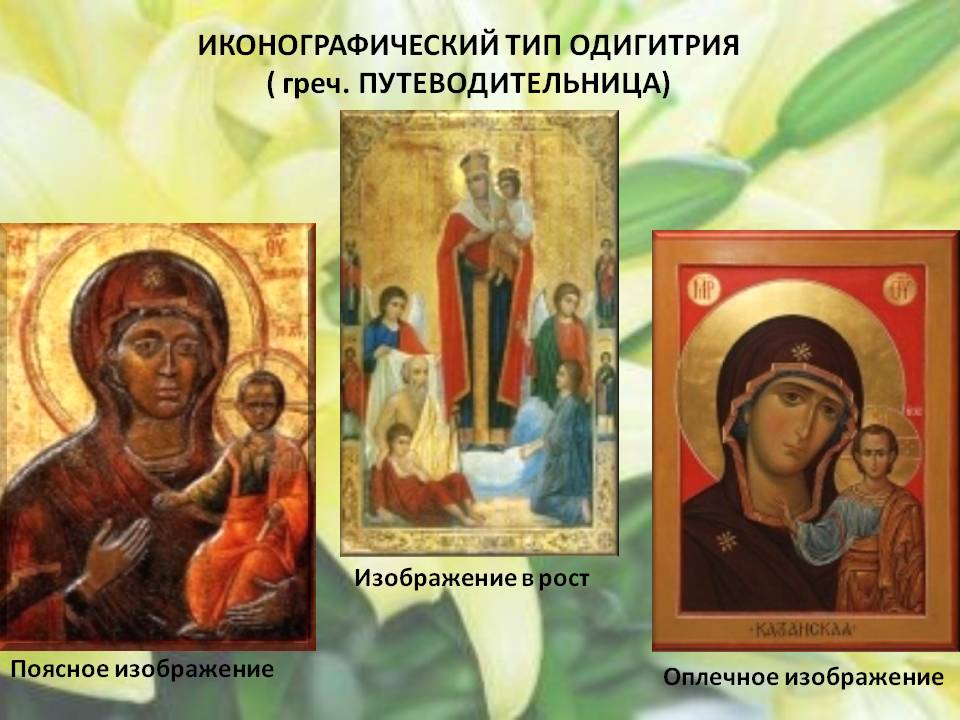
Another type of iconography Hodegetria, Greek Guidebook- this is one of the most common types of images of the Mother of God with the Baby Jesus, which was written not by a baby, and not in childhood, and not by an adult, here it is eternal. According to legend, the Mother of God gave birth to Jesus Christ at the age of 15, which is quite consistent with the southern peoples, and in the icon the Mother of God acquires some severity, no longer young, much more mature. This is the theological dynamic that is depicted on the icons of the Mother of God. The icon painter is interested in showing not a young girl who has become a mother, but it is important to depict the Mother of God.
Icons of this type are constructed as follows: the figure of the Mother of God is presented frontally (sometimes with a slight tilt of the head), on one of Her hands, as on a throne, sits the Infant Christ, and with the other points to Him. The Infant Christ blesses the Mother with one hand, and in Her person, us; the gesture is often directed at those who are present. In his other hand He holds a rolled up scroll (law), sometimes there are variants of an unfolded scroll, skipper and orb, book. The life of a Christian is a path from darkness to God’s wonderful light, from sin to salvation, from death to life. And on this difficult path we have a helper - the Most Holy Theotokos. She was a bridge for the Savior to come into the world, and now She is a bridge for us on the way to Him. With a gesture, the Mother of God orients us spiritually, directing us to Christ, for He “is the Way and the Truth and the Life.” She carries our prayers to Him, She intercedes for us before Him, She keeps us on the path to Him. Having become the Mother of the One who adopted us to the Heavenly Father, the Mother of God becomes the mother of each of us. This type of Mother of God icons has become unusually widespread throughout the Christian world. As a rule, the Mother of God is represented in a half-length image, but abbreviated shoulder-length versions and full-length images are also known.

According to legend, the very first Hodegetria (Blachernae Icon of the Mother of God), painted by the Apostle Luke, was first in Antioch, then in Jerusalem, and from the 5th to the 8th century it was in Constantinople, in the Blachernae Church, where it became famous for many miracles. It was with this icon that Patriarch Sergius walked around in 626. the walls of Constantinople with prayers during the siege of the capital by barbarians. In memory of this and other victories won thanks to the intercession of the Most Holy Theotokos, it was established that annually on Saturday of the 5th week of Great Lent the Celebration of Praise of the Most Holy Theotokos (Saturday of the Akathist) should be celebrated.

This type includes such widely revered icons in Rus' as the Tikhvin, Smolensk, Kazan, Iverskaya, “Three-Handed”, “Support of Sinners”, Petrovskaya, Cyprus, Jerusalem, Alabata, Czestochowa, Georgian, “Passionate” and many others.
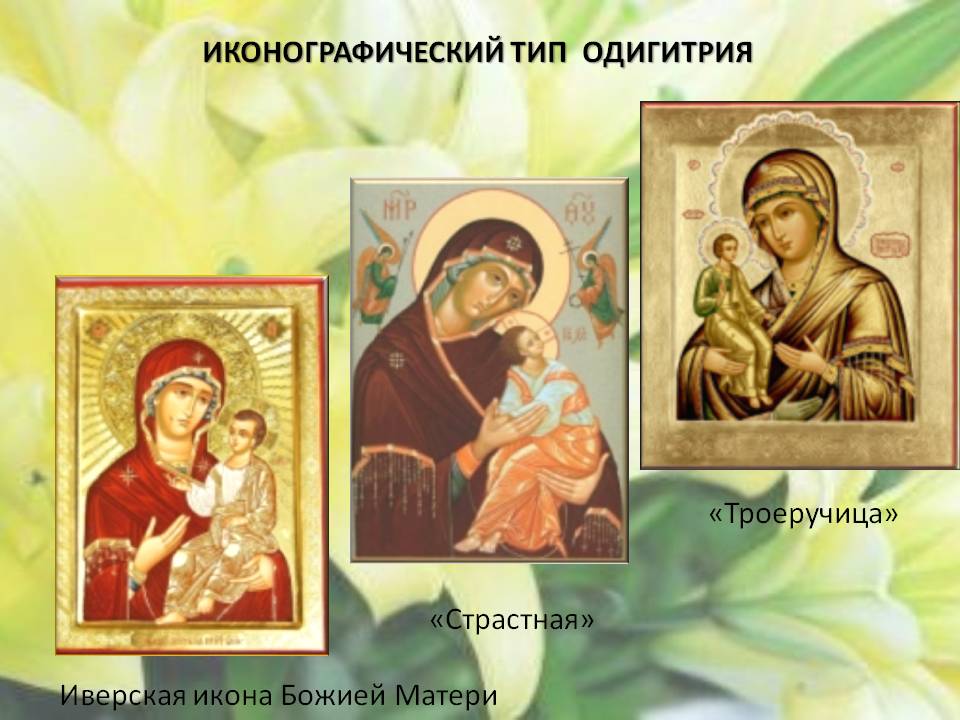
Small iconographic differences in detail are associated with the details of the history of the origin of each specific image. So the third hand of the “Three-Handed” icon was added to St. John Domaskin, when, through his prayer, the Mother of God restored his severed hand. The bleeding wound on the cheek of “Iverskaya” takes us back to the times of iconoclasm; this image was attacked by those who rejected the icon: blood flowed from the blow of the spear, which plunged the witnesses into indescribable horror. The “Passionate” icon usually depicts two angels flying towards the baby with instruments of passion, thereby foreshadowing His suffering for us. As a result of this plot, the pose of the Infant Christ has been changed - He is depicted in a half-turn, looking at the angels, His hands holding the hand of the Mother.
The Mother of God tells the entire human race that the true path is the path to Christ; in these icons Hodegetria appears as a guide to God and eternal Salvation.
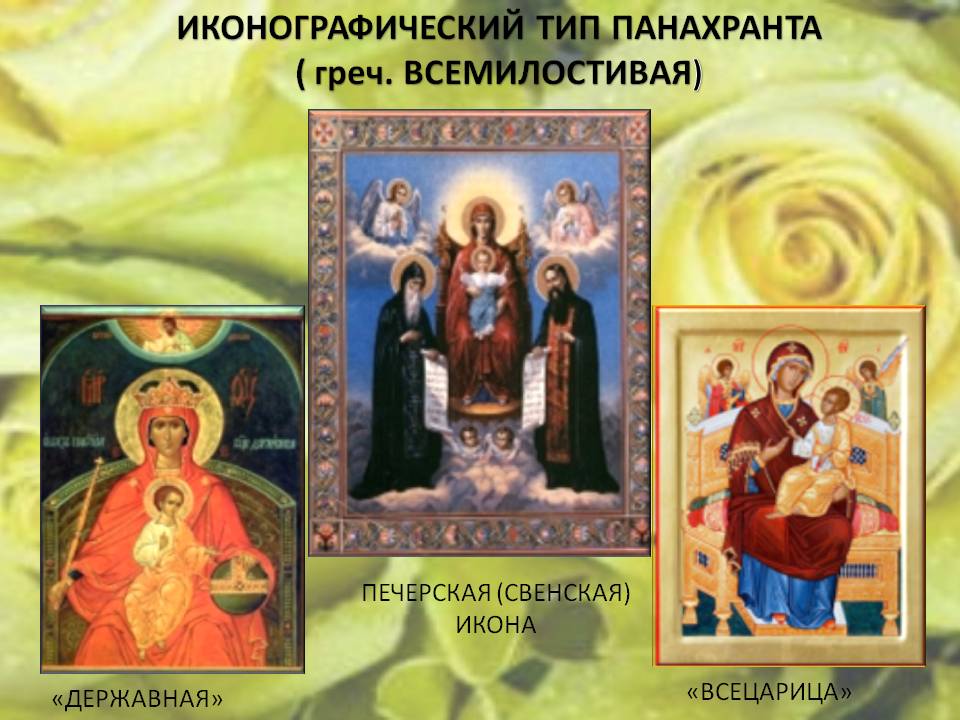
In the 11th-12th century, a type of image of the Mother of God appeared in Byzantium, close to the Hodegetria, but the Mother of God sits on a throne, and the Child Christ is on his knees, called. Panahranta Greek All-merciful. The throne symbolizes the royal greatness of the Mother of God, the most perfect of all people born on earth. In Rus' in the 13th century. The Pechersk (Svensk) icon of the Mother of God with the upcoming monks Theodosius and Anthony of Pechersk received the greatest veneration. This type includes the most famous icons of the Mother of God “Sovereign”, “Vsetsaritsa” and others. The presence of angelic and heavenly forces in the compositions means that the Mother of God, with her humble consent to participate in the act of Incarnation, raises humanity to a level above the angels and archangels, for God, according to the Holy Fathers, did not take on the angelic image, but put on human flesh. In the hymn glorifying the Mother of God, this is what is sung: “The most honorable is the Cherub and the most glorious without comparison is the Seraphim.”
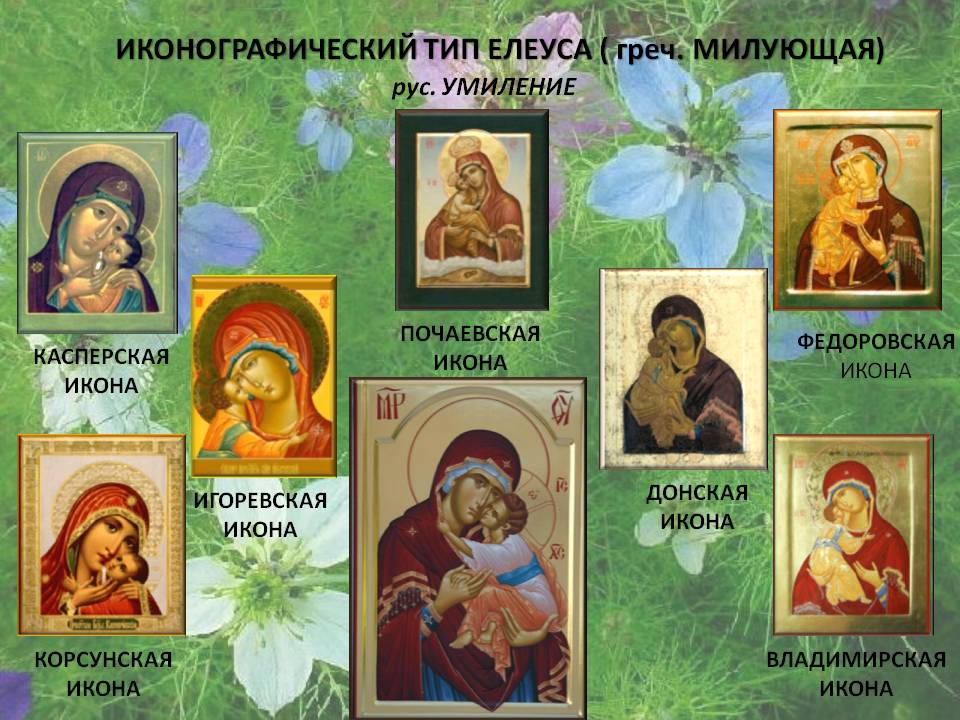
Not earlier than the 10th century, another common iconographic type of the icon of the Mother of God is found Eleusa Greek Merciful, and in Rus' Tenderness. In Greek art this type was called Sweet kiss . In Byzantium, the epithet “Tenderness” was used to designate the Mother of God herself and many of Her icons, but over time, in Russian iconography, the name “Tenderness” began to be associated with a certain iconographic scheme. A characteristic feature of the iconography of Tenderness is the combination of the faces of the Savior and the Mother of God. The Divine Infant clung to the cheek of the Virgin Mary, with his arms and face directed towards the Mother, and the Mother with her face and her whole being was directed towards the baby, their love is boundless. This type of icon represents not just an everyday scene of mutual caressing of mother and child - it is the relationship between the Creator and His Creation, expressed by such an endless love of the Creator for people that He gives His Son to be slaughtered in atonement for universal human sin. Love in the icon connects the heavenly and earthly, the Divine and the human, expressed by the pairing of halos and the contact of two faces. Since the Mother of God symbolizes the Church of Christ, the icon shows the fullness of love between God and man - that fullness that is possible only in the bosom of the Mother Church. The type of tenderness is one of the most mystical types of Mother of God icons. Here the Mother of God is revealed to us not only as a Mother caressing her Son, but also as a symbol of a soul in close communion with God.
Of the icons of this type in Russia, the Vladimir Icon of the Mother of God enjoys the greatest veneration. And not by chance. There are many reasons for this: its ancient origin from the Apostle Luke, and the events associated with its transfer from Kyiv to Vladimir, and then to Moscow, and repeated participation in saving Moscow from the terrible raids of the Tatars...
This type has image options: the Mother of God caressing the Child can be seated, waist-length, standing; The baby can sit on the right or left arm.
Of the icons of the Tenderness type, the most famous are Fedorovskaya, Vladimirskaya, Donskaya, “It Is Worthy,” Pochaevskaya, Kikkiskaya, “Recovery of the Dead,” Volokolamskaya, Zhirovitskaya, Grebnevskaya, Akhrenskaya, Yaroslavskaya, Tolgskaya and others. There are shoulder-length versions of Eleusa: Korsun, Igor, and Kasper icons.
A special type of Tenderness is the image of the Baby sitting on the hand of the Mother of God and dangling his legs. This persecution became very popular in the 15th and 16th centuries. and got the name "Leaping" An example of this type is the Yakhroma Icon of the Mother of God. The characteristic gesture of this composition is that the Child touches the face of the Virgin Mary with his hand. This small detail contains an abyss of tenderness and trust. 21
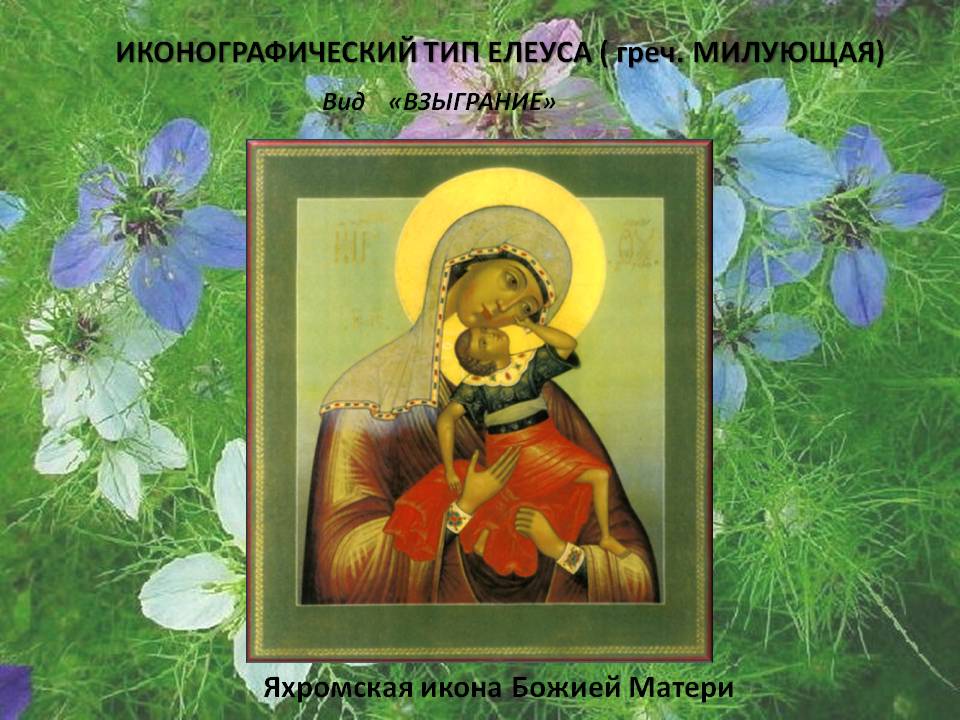
A rare variant of Tenderness represents the type Mammal . The Mother of God breastfeeds the Christ Child. Such a detail is not only an intimate detail, but reveals another theme in the reading of the image of the Virgin Mary. The Mother, feeding her Son, feeds our souls in the same way, just as God feeds us “with the pure verbal milk of the Word of God (1 Peter 2:2), so that as we grow, we may move from milk to solid food” (Heb. 5:12 ).
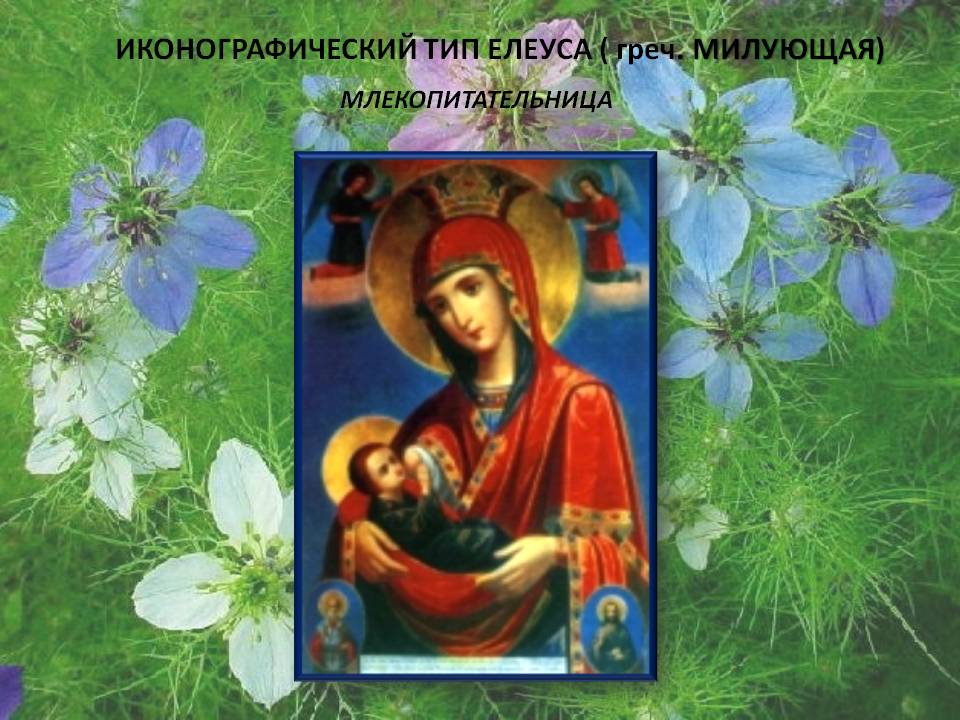
Icon of the Mother of God “Quiet my sorrows.” The icon belongs to the “Tenderness” iconographic type. The Most Holy Theotokos is depicted with the Infant Christ, in whose hands a scroll is unfolded with the words: “Judge righteous judgment, do mercy and generosity to everyone who is sincere; Do not force a widow or an orphan, and do not create malice in your brother’s heart.” These words contain the secret meaning of the image. The Mother of God placed her left hand on her head, which was bowed in tenderness towards the Infant of God. It seems as if She listens to the prayers addressed to Her. The name of the image comes from one of the stichera of the fifth tone at the Monday evening service.
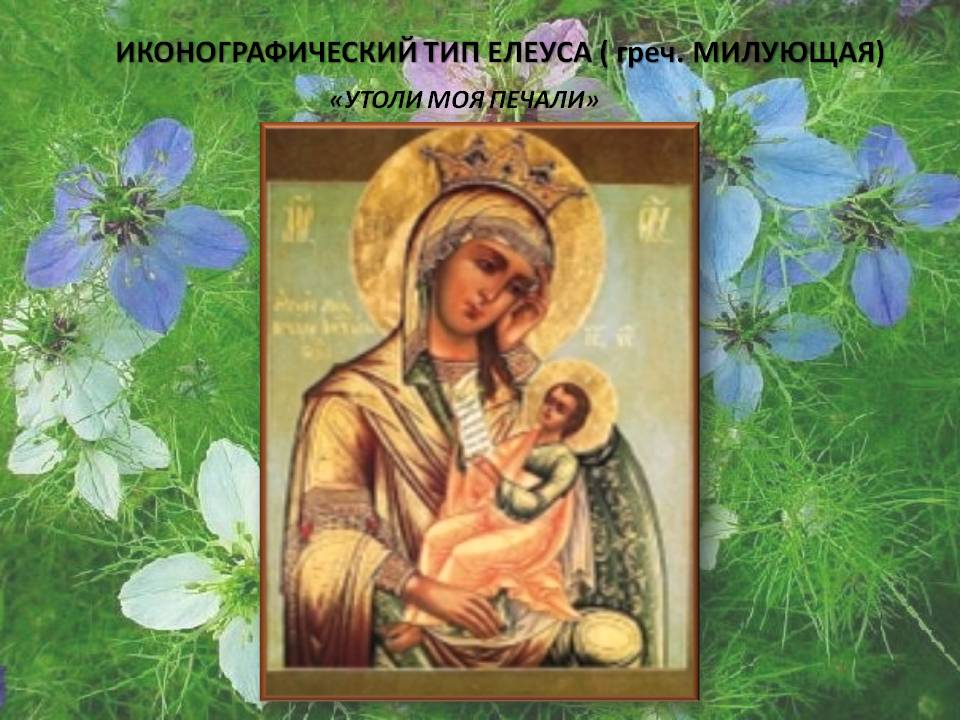
We looked at three main types of iconography of the Mother of God with the Child Christ. Their relationship represented in the icon can be divided into three Christian virtues - faith, hope, love - and so fill these three types of iconography.
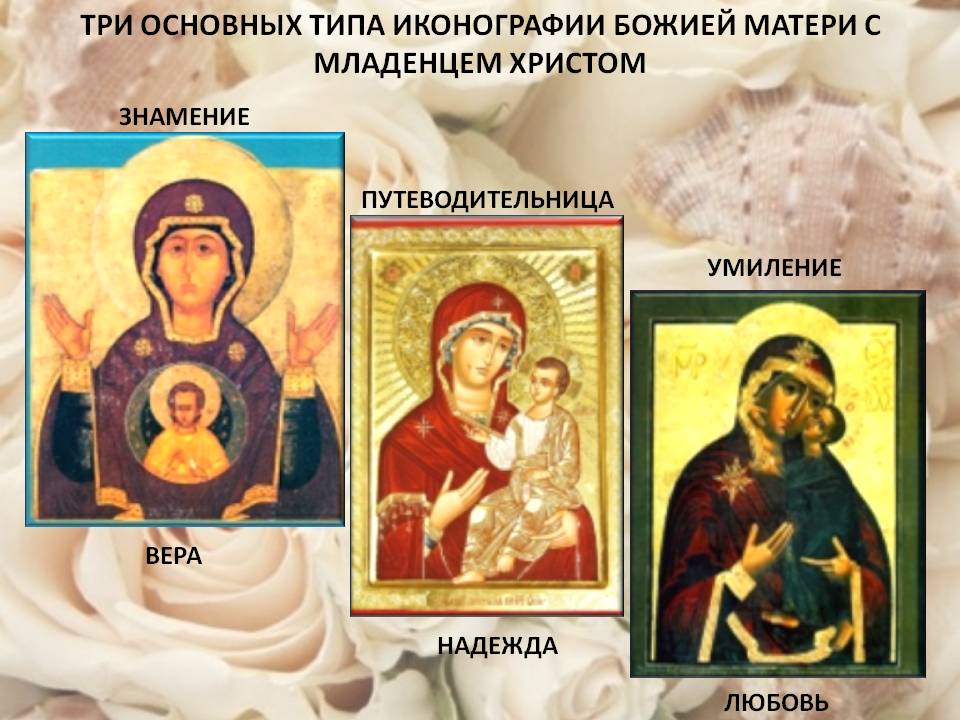
Faith - the iconography of Oranta. Christ became incarnate through the Mother of God, God became man - and we believe in this. Hope - iconography of Hodegetria. Christ said about himself: “I am the Way and the Truth and the Life” (John 14:6), and the Mother of God, the one who helps to walk along this path, is our intercessor, helper, our hope.
Love - the iconography of Tenderness. Here is the Mother of God as a symbol of a soul in close communion and love with God.
Another type of image of the Virgin Mary is a single one without the Child, usually turned three quarters with a prayerful gesture of the hands, called Agiosoritissa Greek Intercessor, became widespread back in the 5th century. Most likely, this image was part of the Greek Deesis. Prayer is an altar barrier that for a long time replaced the iconostasis (the high iconostasis was formed in the 15th century). The simple Deesis consisted of three icons: the Savior, the Mother of God and John the Baptist. The last two are presented in a pose of prayer - in a turn towards the Savior and with raised hands. According to legend, Agiosoritissa was precisely the Mother of God of Deesis.

Over time, Agiosoritissa separated from Deesis and received separate names, such as Paraklisis Greek Petitioner , and in Rus' Bogolyubskaya . The Mother of God in the role of intercessor and mediator.
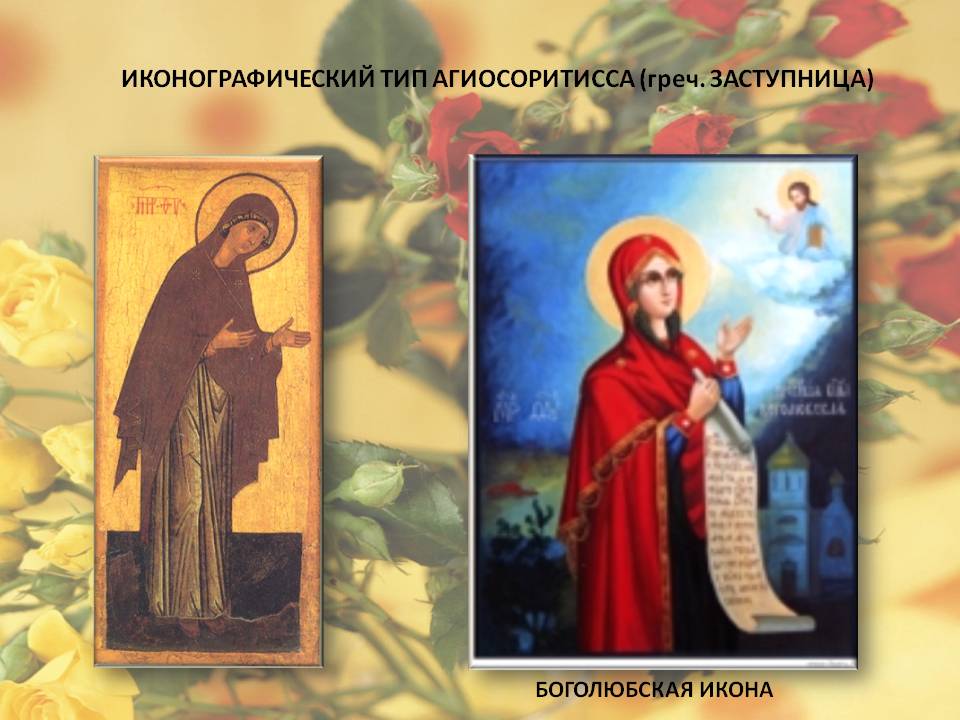
Signs of this type of image:
*one-person, without the Child, representation of the Ever-Virgin;
*the presence of a half-turn to the left or right towards the Savior, the direction of the gaze: at the viewer, at the Savior up or down;
*emphasized gesture of prayer - both hands raised to the Savior (there may be an unfolded scroll of prayer in the hand), position of the hands: folded together, significantly apart, crossed on the chest, or absent in shoulder images.
* image full-length, half-length, shoulder-length.
In addition, there are many known compositions based on liturgical texts and chants (hymnographies), united under the general name "akathist icons" .
The main meaning of this type of icon is the glorification of the Mother of God. This type is rather collective, since the iconography here is built not on the principle of a theological text, but on the principle of illustrating one or another epithet with which the Mother of God is called in the akathist or other works. The composition of the icon is built from the superposition of the image of the Mother of God with the Child Christ of previous types with additional elements, symbols of the Old Testament prototypes.
Example "Burning Bush". There are two images of this icon. First, the “Burning Bush” is depicted as a bush engulfed in flames, above which rises the Mother of God, visible from the waist up, with the Child in her arms. This is a rare image. Much more often we see a different image, but it has a more complex iconographic scheme; this is late iconography of the 16-17 centuries.
In church hymns, the Mother of God is often compared to the Burning Bush, the unburnt thorn bush that the prophet Moses saw on Mount Horeb (Ex. 3:2). The similarity between the Burning Bush and the Mother of God lies in the fact that just as the Old Testament Bush remained unharmed during the fire that engulfed it, so the Most Pure Virgin Mary, who gave birth to Jesus Christ, remained a Virgin before and after Christmas.

In the center of the icon there is an image of the Mother of God with the Child; in her hands She holds a number of symbolic attributes associated with the Old Testament prophecy: the Mountain from the prophecy of Daniel, the Gate of Ezekiel, the Ladder of Jacob, leaning its upper end against the shoulder of the Mother of God - a sign that through the Mother of God he came to earth The Son of God, who takes all who believe in him to heaven. Sometimes they write a rod - a symbol of the Savior, called in church hymns “the rod from the root of Jesse” and others. This image is enclosed in an eight-pointed star formed by two quadrangles - green and red (the natural color of the Bush and the color of the flame that declared it). Four Old Testament scenes are depicted around: Moses before the Bush, Jacob's dream, Ezekiel's Gate and the Tree of Jesha. Another theme of the icon is the service of the angels to the Mother of God and the worship of the heavenly powers to the birth of God from the Virgin - their image is located in the rays of an eight-pointed star; among them are archangels and nameless angels - personifications of the elements, known from the apocrypha. In the corners of the red quadrangle are four symbols mentioned in the Apocalypse of John the Theologian: a man, a lion, a calf and an eagle. Gregory Dvoeslov explained these symbols in such a way that Christ took on flesh (man), sacrificed himself (calf), broke the bonds of death (lion), and ascended to heaven (eagle). Sometimes a book is depicted with animal symbols - then the symbolism of the evangelists is spoken of. The Evangelist Matthew is symbolized as a man because he speaks about the messianic mission into the world of the Son of God, predicted by the prophets. Evangelist Luke is depicted as a calf, emphasizing the sacrificial, redemptive ministry of the Savior, which the evangelist describes. Evangelist Mark - symbolized by a lion, revealing the power and royal dignity of Christ. Evangelist John - an eagle, depicts the height of the teachings of Christ and the Divine mysteries communicated in it.
Now about the Kaluga Icon of the Mother of God. The sources of the iconography are not entirely clear. The image of the Most Holy Theotokos reading the book of the prophet Isaiah is based on a plot from the apocryphal Gospel of Pseudo-Matthew. In it, among the activities of the Mother of God in the Jerusalem Temple, reading the books of the Holy Scriptures is named. She holds the book in her right hand, and prayerfully presses her left hand to her chest.

There is one interesting fact associated with the discovery of the icon in the house of landowner Vasily Kondratievich Khitrovo. It should be noted that a relative of Khitrovo was married to the nephew of Evdokia Lopukhina, who had an estate sixty kilometers from Tinkovo. Evdokia Lopukhina - the last Russian queen, the first wife of Peter1, the mother of Tsarevich Alexei, was subsequently cut into a nun with the name Elena. And during her stay in the Suzdal Intercession Monastery, her portrait was painted in monastic robes with an open book. This was almost forty years before the discovery of the Kaluga Icon of the Mother of God. In the icon, the Mother of God deigned to appear in an appearance strikingly similar to the lifetime portrait of Queen Evdokia Lopukhina. How and whether the Kaluga Icon of the Mother of God and the portrait of Lopukhina were connected remains unknown. The Most Holy Theotokos not only showed us her image during her lifetime, but to this day the Mother of God does not leave us and consoles us.
In 1863, the abbot of the monastery in the name of the Holy Prophet John the Baptist on Mount Athos with several brothers went to Moldavia on the affairs of the monastery. One of the tasks was to purchase an icon of the Mother of God for the monastery. For this purpose, the monks began to look for an artist distinguished by piety and abstinence in order to order him the desired icon. Such an artist, of advanced years, was found in Iasi. An agreement was concluded with him so that he would fast diligently while working and not trust the execution of the order to anyone else. When the icon painter set to work, with the blessing and infirmity of old age, relying more on the help of the Mother of God than on his own strength, the work went successfully. But when the clothes were painted and he began to paint the Divine faces, the work stopped: the icon painter could not paint the faces well. The Athonite monks, consoling themselves and the grieving icon painter, advised him to pray to the Mother of God for help. He did just that and began to pray and fast. One day he spent the whole day in prayer and the next went to the workshop. Approaching the icon, he was amazed to see that the faces of the Mother of God and the Child Christ were ready. Awe overcame the icon painter, and he did not dare to touch the faces depicted on the icon with complete perfection. This icon is called "Self-Writing".

There is an unusual image of the Virgin Mary, called. Painted in light, who appeared in the Athos Panteleimon Monastery in 1903. During the distribution of alms at the Holy Gates of the Panteleimon Monastery, a photograph was taken, which later showed the image of the Mother of God accepting alms from the hands of an elder monk among the poor brothers. The Blessed Virgin deigned to capture Her Divine features with the help of photography, which is translated from Greek as photography. The resulting image received the name “Painted with Light”. N e when Saint Andrew, the Fool for Christ's sake, going around the Heavenly Abodes, wanted to see the Mother of God there, but heard a voice telling him that the Most Holy Theotokos had descended into the world to help all who called on Her name.
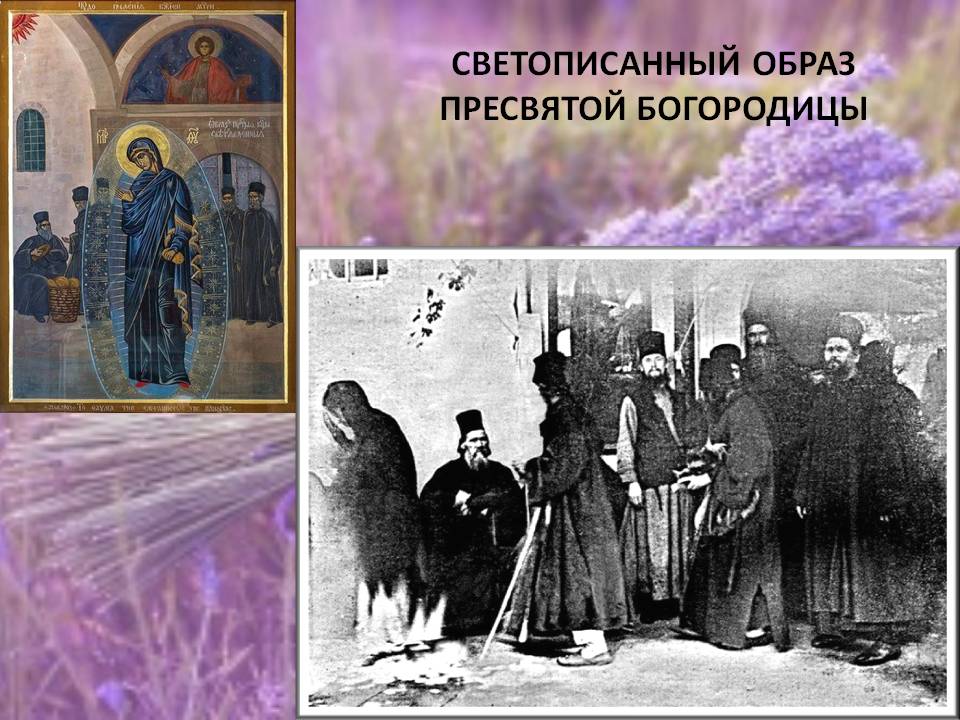
The Most Holy Theotokos often appears, especially on Holy Mount Athos, “simply,” hiding Her glory. So in this case, the Mother of God descended in the form of a poor petitioner and accepted alms from the hands of the elder monk in order to console the poor brothers and support the good tradition of the Monastery. Photography served as a factor of reassurance in the existence of the spiritual world. For the centenary, an iconographic “version” of the photograph was created for liturgical use and a service was compiled.
Such icons have a special meaning for the Church. They not only elevate our mind to the prototype, but show us the divine features of the prototypes themselves. They are one of the types of Divine revelation.
The image of the Mother of God occupies an exceptional place in Orthodox spirituality, as can be seen from the huge number of icons dedicated to Her. You can count more than 860 icons of the Mother of God. For most icons, separate celebrations are established; prayers, troparia, kontakions and sometimes akathists are written for them.
One Western theologian expressed the meaning of veneration of the Mother of God this way: “the best veneration of Mary is to imitate Her in Her love for Her Son and our Lord Jesus Christ.” This is the love that the Mother of God icons teach us.
In addition to the icons of the Mother of God, Her iconography includes icons of the Mother of God feasts, the days of the annual liturgical cycle established in honor of the Most Holy Theotokos.


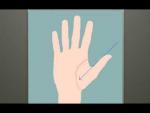





 Nail care
Nail care Prom hairstyle for long hair
Prom hairstyle for long hair 18 wonderful New Year cards that even a child can make
18 wonderful New Year cards that even a child can make The best set of exercises for morning exercises
The best set of exercises for morning exercises